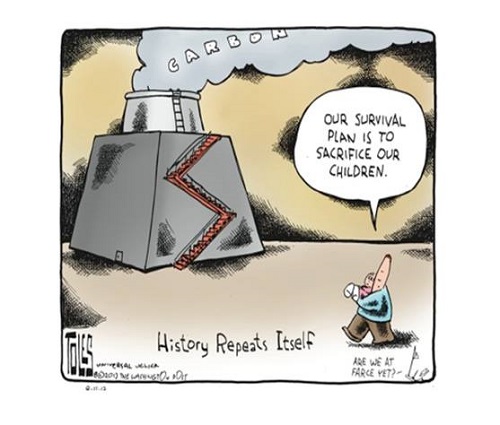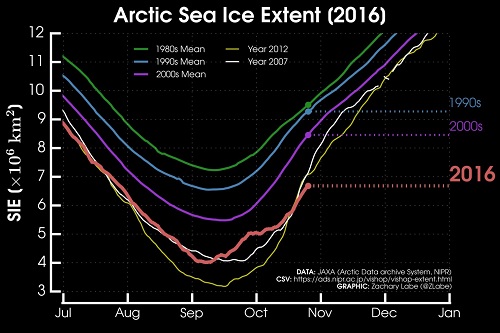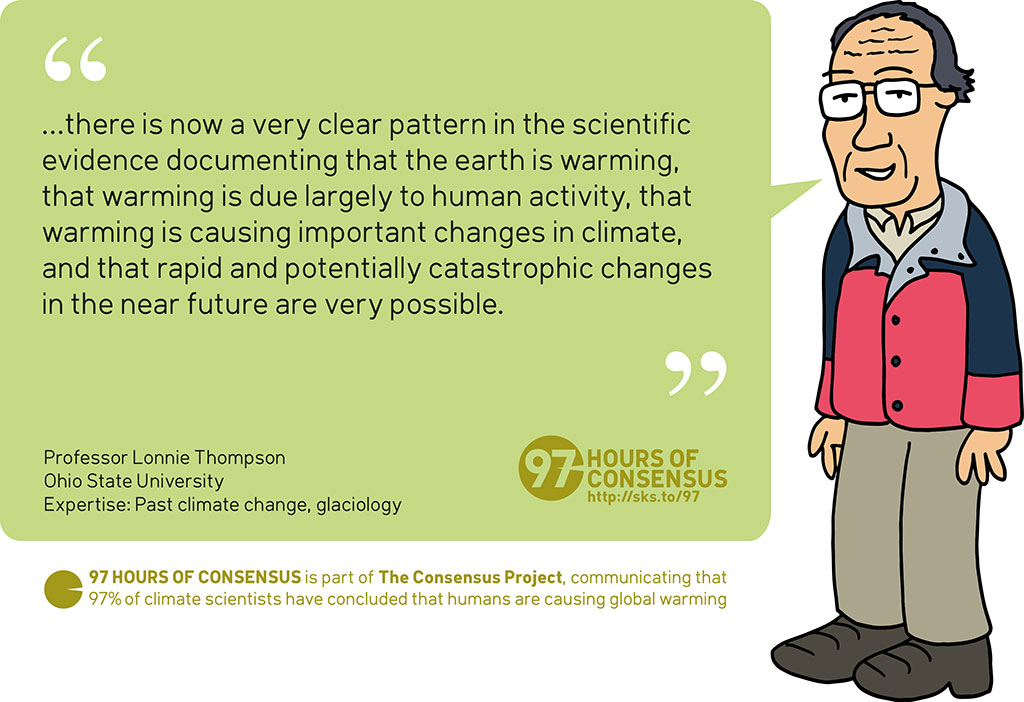2016 SkS Weekly Climate Change & Global Warming Digest #44
Posted on 30 October 2016 by John Hartz
Story of the Week... SkS Highlights...La Niña Update... Toon of the Week... Quote of the Week... Graphic of the Week... SkS Spotlights... Video of the Week... Coming Soon on SkS... Poster of the Week... Climate Feedback Reviews... SkS Week in Review... 97 Hours of Consensus...
Story of the Week...
The Paris Agreement, slated to come into force on the 4 November, contains a two-pronged, long-term goal for limiting global warming – holding to “well-below 2C above pre-industrial levels” and a more ambitious aim to “limit the temperature increase to 1.5C”.
A new study, just published in Science, shows what difference the extra 0.5C of warming could make for Mediterranean habitats during this century.
A 2C temperature rise would be enough to cause shifts in Mediterranean ecosystems that are unmatched in the past 10,000 years, the study says. Only limiting warming to no more than 1.5C would keep ecosystem changes within the fluctuations of the Earth’s recent past.
And if greenhouse emissions aren’t curbed at all, the study warns that the warm forests of southern Spain and North Africa will likely be taken over by desert by the end of the century.
Warming of 2C will push Mediterranean habitats into ‘unprecedented situation’ by Robert McSweeney, Carbon Brief, Oct 27, 2016
SkS Highlights...
Using the metric of comments garnered, the two most popular of the articles posted on SkS during the past week are:
- Tracking the 2°C Limit - September 2016 by Rob Honeycutt
- 'The atmosphere is being radicalized' by climate change by Dana Nuccitelli (Climate Consensus - the 97%, Guardian)
La Niña Update...
This time last year the world’s weather was being dominated by one of the strongest El Niño events on record. As surface waters in the equatorial Eastern Pacific warmed by more than 2°C, a chain reaction of extreme weather events was set in motion. From torrential rains in Peru and huge storms pounding the coast of California, to drought and bushfire in Australia and Indonesia and catastrophic floods in south-east India (submerging parts of Chennai under eight metres of water), this El Niño really packed some punch. By May 2016 the El Niño conditions had gone, but the big question now is whether El Niño’s opposite phase – La Niña – is waiting in the wings?
La Niña, which is associated with abnormal cooling of equatorial Eastern Pacific waters, usually does follow El Niño, and in this case we’d expect to see La Niña emerge by the end of this year or in early 2017. And like El Niño, La Niña also tends to whip up some weird weather, often bringing cooler temperatures to many regions, drier conditions to East Africa and wetter weather over south-east Asia.
After El Niño, what weird weather could La Niña bring? by Kate Ravilious, Guardian, Oct 23, 2016
CLIMATE PREDICTIONS—KIND OF like romantic comedies—are full of will they/won’t they suspense. Like this year’s La Niña. In September, the National Weather Service cancelled its months-long lookout for the climate phenomenon—which, as a counterpoint to El Niño, is associated with cooler overall global temperatures. Then, last week, the agency reversed. Its Climate Prediction Center predicted a 70 percent chance of La Niña forming, and folded that prediction into its Winter Weather Outlook. If true, that means the next few months will be warm and dry in the southern half of the US; wet and cool in the north.
Why Scientists Keep Changing the Forecast for a La Niña Winter by Nick Stockton, Science, Wired, Oct 27, 2016
Toon of the Week...

Quote of the Week...
A firm plan for potentially easing the shipping industry’s impact on the climate will be delayed for seven years under a roadmap drafted by a United Nations agency on Friday.
The lackluster outcome at the end of a week of environmental talks in London deepened the disparity between ship and plane operators and much of the rest of the world when it comes to tackling global warming. The shipping industry participated in the negotiations on behalf of some nations.
The U.N. agency, the International Maritime Organization (IMO), described Friday’s agreement as “another good news story for the #environment” on Twitter — even as it was being broadly criticized by others.
“The fact that there’s a roadmap is good,” said John Maggs, a policy advisor at the nonprofit Seas At Risk who attended the talks. But he criticized it for lacking targets or meaningful timelines and for lacking ambition. “There’s nothing in the roadmap.”
Shipping Industry Postpones Climate Plan Until 2023 by John Upton, Climate Central, Oct 28, 2016
Graphic of the Week...

Arctic sea ice is at a record low and could, in spurts, disappear within our lifetimes by Jason Samenow, Capital Weather Gang, Washington Post, Oct 27, 2016
SkS Spotlights...
The National Geographic documentary series deals with the political realities of climate change that our presidential election has largely ignored.
Years of Living Dangerously Returns To Television Sunday by John Light, Bill Mowers & Company, Oct 28, 2016
Video of the Week...
See How Arctic Sea Ice Is Losing Its Bulwark Against Warming Summers by Maria-José Viñas, NASA’s Goddard Space Flight Center, Oct 28, 2016
Coming Soon on SkS...
- Coal doesn't help the poor; it makes them poorer (Dana)
- US Transportation Sector Emissions Comparable to 1980 Mt. St Helens Eruption Occurring Every 3 Days (Ryan Logtenberg)
- Global weirding Episode 3 (Katharine Hayhoe)
- Guest Post (John Abraham)
- The Climate Questions the Next President Should Answer (Brian Kahn & Andrea Thompson)
- 2016 SkS Weekly Climate Change & Global Warming News Roundup #45 (John Hartz)
- 2016 SkS Weekly Climate Change & Global Waming Digest #45 (John Hartz)
Poster of the Week...

Climate Feedback Reviews...
Climate Feedback asked its network of scientists to review “Hillary Clinton Boards The Climate Crisis Train To Nowhere” by Roy Spenser (Forbes, Oct 25, 2016). Eight scientists analyzed the article and estimated its overall scientific credibility to be ‘very low’.
Click here to access the detailed review.
SkS Week in Review...
- 2016 SkS Weekly Climate Change & Global Warming News Roundup #44 by John Hartz
- Debunking climate myths with Leonardo DiCaprio's Before The Flood by John Cook
- Climate change could push risk of ‘megadrought’ to 99% in American southwest by Robert McSweeney (Carbon Brief)
- Global weirding with Katharine Hayhoe: Episode 2 by Guest Author
- Tracking the 2°C Limit - September 2016 by Rob Honeycutt
- 'The atmosphere is being radicalized' by climate change by Dana Nuccitelli (Climate Consensus - the 97%, Guardian)
- 2016 SkS Weekly Climate Change & Global Warming Digest #43 by John Hartz
97 Hours of Consensus...
































 Arguments
Arguments






























Perhaps the most apt climate change cartoon I have ever seen.